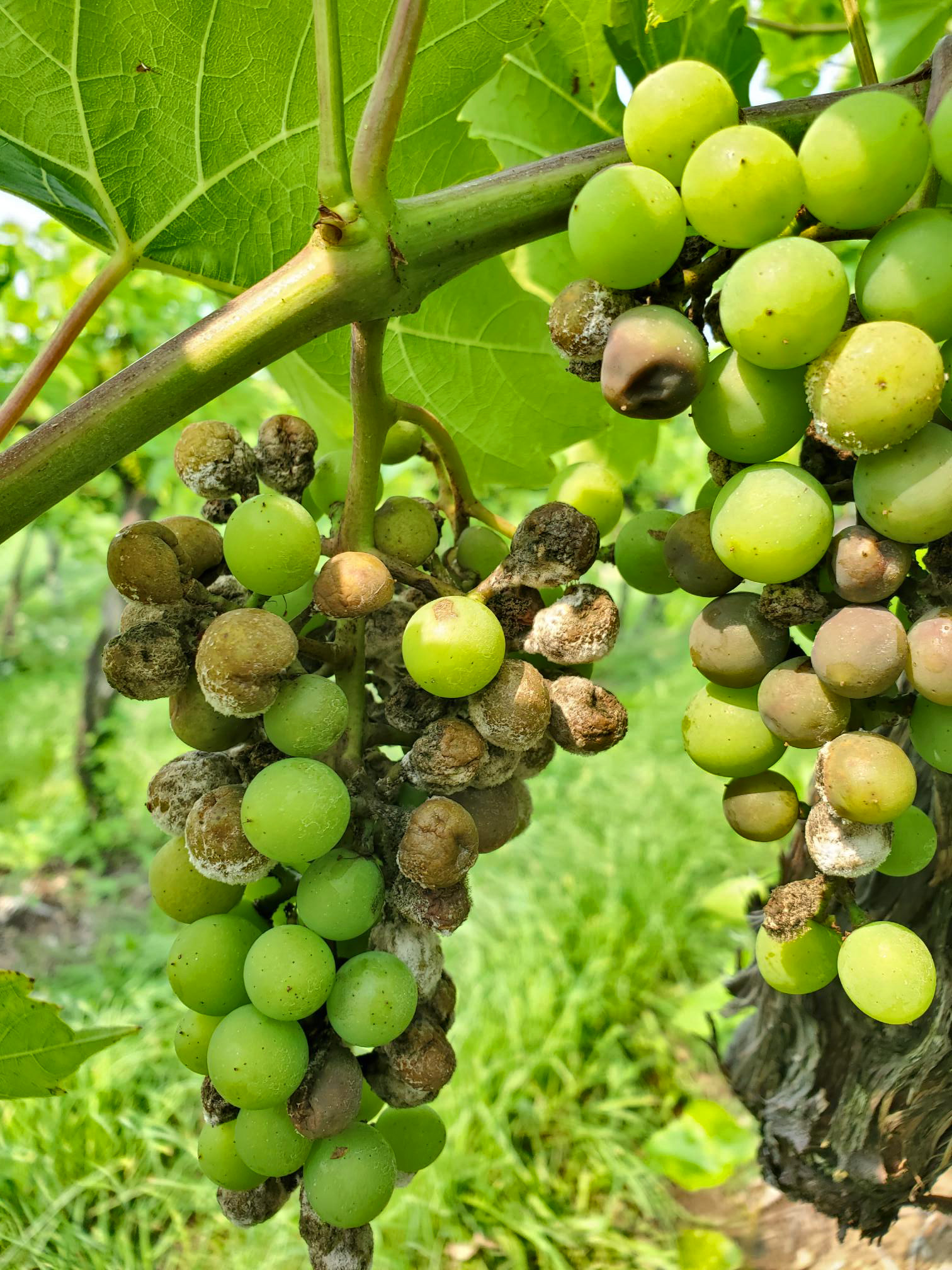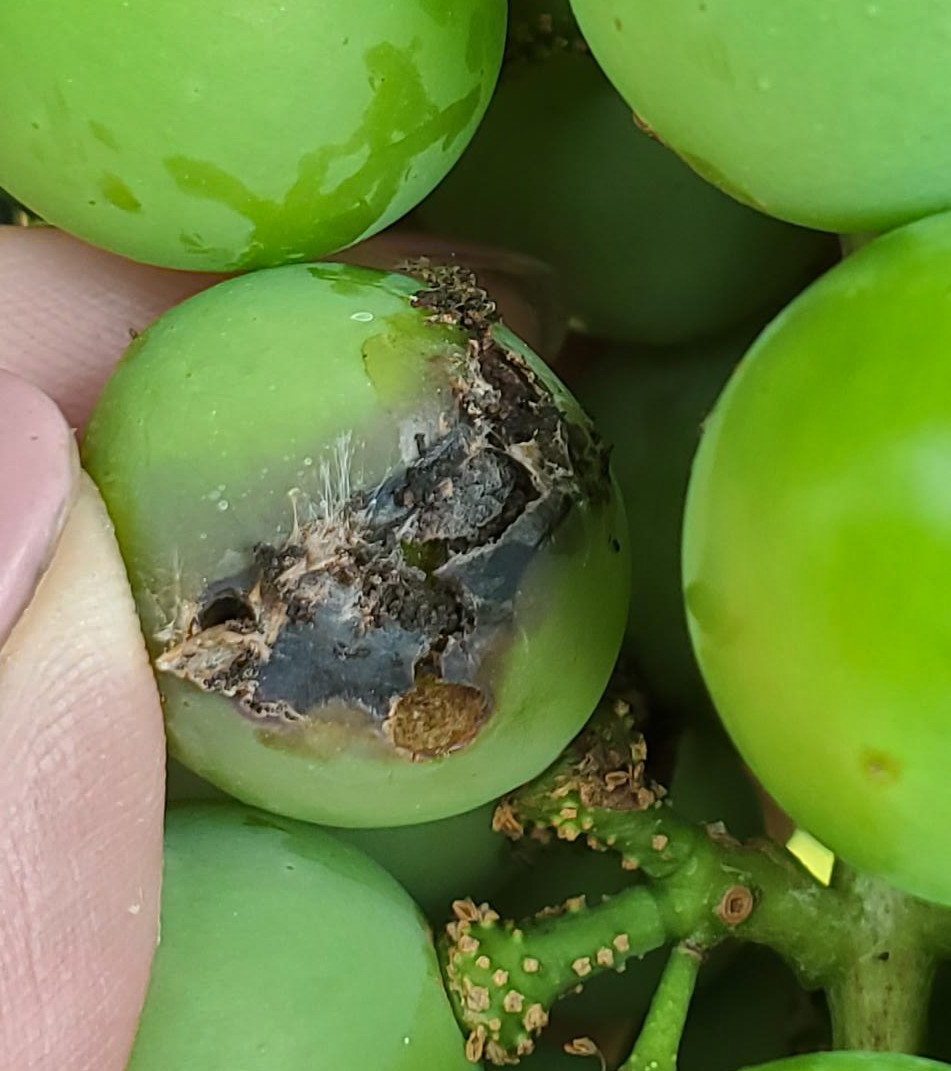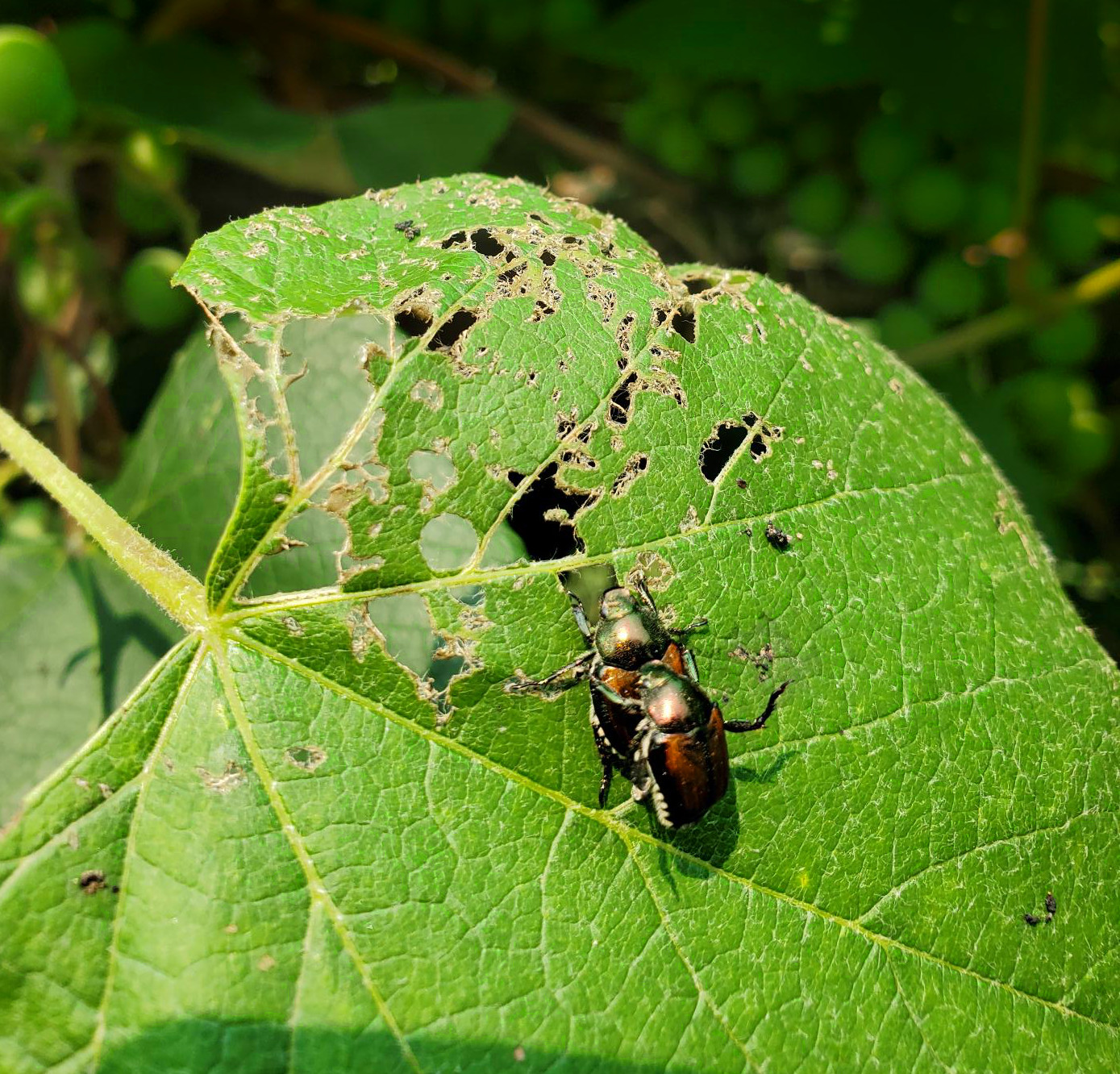Michigan grape scouting report – July 22, 2021
Summer pests and diseases are here.

Weather
Temperatures this past week were consistent. Highs in southern parts of the state were in the mid-70s to low 80s. Lows were in the mid-60s. Northern grape regions were 5-10 degrees cooler. A low pressure system brought rain to the northern areas on Tuesday and again on Thursday. Southern parts of the state only saw the rain from this system on Tuesday but made up for it with a separate system that passed along the southern Michigan border on Friday and Saturday. Total rain amounts for the week were around 1-2 inches statewide.
The forecast for the coming week is for similar conditions to last week, just a little warmer. Highs should be in the low to mid-80s for much of the state. Lows will be in the mid-60s in much of the state, near 70 in the southwest.
With the seasonal week, we picked up an average number of growing degree days (GDD) last week: 130-150 GDD base 50. The southwest region is 385 GDD base 50 ahead of the northwest region. Statewide, we are less than a week ahead of the five-year average.
|
Northwest Michigan GDD summary from March 1 - July 19, 2021 | |
|---|---|
|
Northwest stations |
GDD 50 F |
|
Petoskey (Petoskey) |
1024 |
|
Traverse City (NWMHRC) |
1194 |
|
Old Mission (Old Mission) |
1149 |
|
Average for northwest region |
1131 |
|
Average last week |
1002 |
|
Southern Stations |
|
|
Benton Harbor (SWMREC) |
1544 |
|
Lawton (Lawton) |
1546 |
|
Fennville (TNRC) |
1365 |
|
Average for southwest region |
1515 |
|
Average last week |
1368 |
|
Romeo (Romeo) |
1468 |
|
Average for southeast region |
1498 |
|
Average last week |
1347 |
Vine growth
Visible fruit changes have been slow recently. In southwest Michigan, most varieties are at berry touch to bunch closure, depending on how tight-clustered the variety is. Some sites impacted by the spring freezes are not expected to be harvested because of the low crop. In these freeze-damaged sites, a reduced pest and disease program may be warranted. See “Pest management approaches in a winter or freeze damaged grape vineyard” from Michigan State University Extension for recommendations.
In northern vineyards, most varieties are near berry touch. See this chart for grape growth stages.
Horticulture
Hedging is being done in vineyards in southwest Michigan now. Hedging's main goal is to remove excess primary and lateral shoot growth from the canopy's top and sides, preventing shading and shoot entanglement between vine rows and allowing worker and tractor traffic through the vineyard. Hedging reduces the canopy by cutting primary and lateral shoots, but it does not directly reduce the vine's inherent vigor. When done in early to midsummer, hedging can further promote growth by inducing lateral shoot growth in vigorous vines.
Hedging is usually performed from fruit set to véraison, when primary and lateral shoots begin to bend (45-degree angle). It is important to keep leaves, fruit and developing buds exposed to enough light in dense canopies with excessive vegetative growth. Hedging too early in the growing season should be avoided because it can cause lateral growth and canopy density to increase.
Diseases
At this time of year, the diseases to focus on are downy mildew and powdery mildew. Fungicides that include broad-spectrum/contact fungicides like the EBDCs (FRAC M3) and captan are effective products for resistance management. Viticultural practices that reduce canopy wetness such as good irrigation timing, leaf removal and good weed management can reduce many of these diseases in a vineyard. Typically, DMIs (FRAC 3), captan and EBDCs (FRAC M3) are effective for phomopsis, black rot, anthracnose as well. As we get farther into the season it will be difficult to manage black rot infections.
Downy mildew can cause fruit infection and late season defoliation. Flowers remain susceptible until two weeks after bloom. Downy mildew is caused by a fungal-like organism, so many site-specific systemic fungicides that target other spring diseases do not work on downy mildew. Effective fungicides for downy mildew include products in FRAC codes 4, 11, 21, 40 and 45 as well as phosphorus acid salts and some biologically-based products.

If powdery mildew is the only concern, there are a number of products that are effective (FRAC codes 3, 7, 11, 13, U8, 50, and U13 as well as sulfur). Combining fungicides from different FRAC classes should also be effective while helping with resistance management.
As we approach bunch closure, it is important to consider botrytis management. Several strategies contribute to good botrytis bunch rot management including opening up the canopy, properly applying fungicides, and using resistant cultivars when possible. Good botrytis control depends on getting good coverage. Just before bunch closure is the last chance to apply a fungicide to the inner part of the developing cluster. Fungicide resistance management is also important. The most effective products for botrytis are site specific and prone to resistance development. A new Michigan Grape Fact Sheet is now available for managing botrytis bunch rot.
Remember as you choose a fungicide, check the guide for potential phytotoxicity of certain sprays on Concord grapes especially (this has been particularly noted for fungicides like Revus Top). Phytotoxicity risk is higher with high temperatures and quickly growing vines. Also, there is a significant phytotoxicity risk with specific contact products such as copper and sulfur for Labrusca type grapes (Concord and Niagara).
As the season continues, remember to manage fungicide resistance and avoid applying similar products back-to-back. This is particularly important with site-specific systemic fungicides. To reduce the development of resistance with systemic fungicides:
- Do not make more than two applications per season of the same FRAC code.
- Do not make two consecutive applications of the same FRAC code.
- Rotate with unrelated fungicides in a different FRAC code that have efficacy on the target pathogen.
- Include a contact multisite fungicide into a program (e.g., sulfur, captan, oils or biological fungicides).
This is a good time to scout for suspicious issues related to other vine stressors. Many of these problems can be abiotic including nutrient related issues and graft incompatibility, but some of the biotic problems can be caused by grapevine trunk diseases or grapevine viruses. If you are interested in taking samples and testing, you can send them to MSU Plant & Pest Diagnostics. Please see these articles on grapevine trunk disease and sampling for grapevine viruses.
Insects
Catches of male grape berry moth in traps are variable between vineyard sites, and most of southwest Michigan is at least two weeks past the predicted start of egglaying of the second generation. This was predicted to be between June 30 and July 3, 2021. Scouting found some larvae in grape clusters, mostly at the edge of vineyards. Season-long protection of clusters from grape berry moth larvae requires attention to this second generation, so high pressure sites should be scouted and if needed those should be protected by an additional cover spray. The heavy rains can also wash residues off clusters, so keep this in mind when planning cluster protection programs. Some guidance on rainfall effects on insecticides is available in “Rainfast characteristics of insecticides on fruit.” It was developed for apples, but still contains good information for grape growers.
There are a number of broad-spectrum insecticide options that have activity against young larvae such as Altacor, Delegate and Verdepryn. Imidan is also effective against grape berry moth but must be applied in water that is pH 5-5.5 for maximum activity. Multiple pyrethroid insecticides and the carbamate Sevin are also registered and can provide a week of protection, but they can also disrupt biological controls. For more detailed information to help with choosing the right insecticide, see: Mid-season management of grape berry moth.

Japanese beetle activity is still increasing in some vineyards, feeding on leaves. Labrusca grapes can tolerate damage from Japanese beetles, but vinifera and hybrid wine grapes with thinner leaves are more easily defoliated. Susceptibility can vary widely among cultivars in adjacent rows/vines so focus management where it is most needed to save money. Treatment is usually only necessary if significant defoliation is seen. A well-timed broad spectrum insecticide treatment should help manage grape berry moths and Japanese beetles at the same time.

Upcoming meetings
Viticulture Field Day will be returning to an in-person event this year. The event location is 12 Corners Winery in Benton Harbor, Michigan, on July 28, 2021. This will be an all-day event. Check in opens at 8 a.m., presentations start at 9 a.m. The traditional steak dinner and wine tasting will return. There will be limited attendance. Pre-registration is highly recommended.
Related articles
- Southwest Michigan Fruit Update – July 20, 2021
- A Mobile Guide for Grape IPM Scouting in North Central and Eastern U.S.
- Early season vineyard disease management
- Mid-season management of grape berry moth
- Early season vineyard management
- Michigan grape scouting report – July 15, 2021
- Pest management approaches in a winter or freeze damaged grape vineyard



 Print
Print Email
Email